Agency producers are not spending enough of their time on the sales-related activities that they and their managers think they ideally should.
Instead they are spending more time than they think they should on administration and client service, according to some of the results of a survey by ReSourcePro Analytics and Insurance Journal.
For example, the majority of producers spend 25-50 percent of their time selling and 25-50 percent of their time servicing or troubleshooting accounts, according to a section of the Insurance Operations Best Practices Survey.
Yet, 83 percent of respondents — producers and managers— report that producers should spend less than 25 percent of their time servicing or troubleshooting accounts.
Only about one-third of producers spend more than half their time selling, which is what 92 percent reported that ideally producers should be spending over half their time doing.
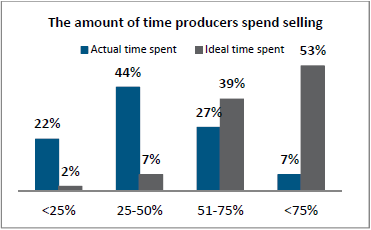
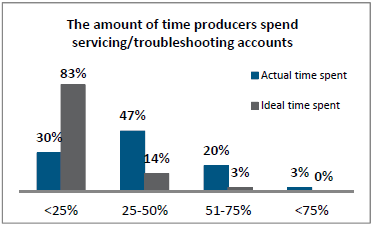
The survey also found a similar gap between what service personnel say they ideally should be doing and what they actually end up doing on the job.
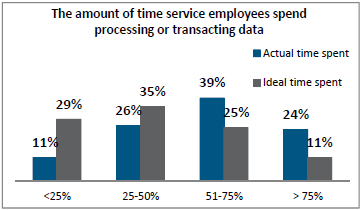
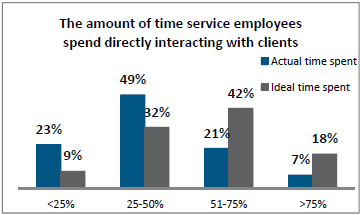
At the same time, the survey uncovered another gap, a perception gap: agency principals and managers tend to believe that most employees are mainly doing what they should be doing.
Ninety-one percent of managers surveyed said that the skills, talents, and experience of their employees are matched to their daily work. Only 66 percent of employees said they agree or strongly agree with that statement.
Also, more than half of managers believe that backlogs are not a problem while only 36 percent of employees agree.
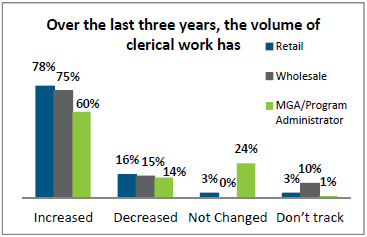
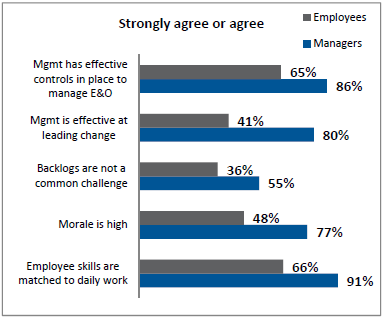
Dan Epstein, chief executive officer, ReSourcePro, hopes the survey results will encourage agency discussions of these gaps and their meaning for agency productivity.
“We see this as a huge opportunity to improve productivity because what producers are saying is they want to be spending significantly more of their time out selling, generating new business, providing a higher level of competitive services to their clients but they’re just not having enough time to do that,” Epstein says.
Part of the challenge is for an agency to have processes for delegating non-sales tasks to other personnel, according to K. Patrick Armstrong, CPCU, vice presdient of Business Development at ReSourcePro and a former independent agency principal and reinsurance broker.
“Without a clearly defined internal process for delegating these tasks to service personnel, it becomes very easy for producers to get sucked into the service trap,” says Armstrong. “What an agency can do is create a process that makes it very easy for the producer to rely on the service staff to do what the service staff does best. Sometimes that requires educating the clients on that process. But it starts with having a process and then managing the adherence to the process.”
Armstrong thinks the survey results could also be a catalyst for discussing whether some employees, in lieu of doing more of what they should be doing, are doing work they actually are not qualified or trained to do.
“Because of the nature of the business and the high pace of activity within an agency, work is thrown at people and because they come to their job every day wanting to serve and take care of the client and support the agency, they do that work willingly. But they really haven’t taken the time to step back and say, ‘Maybe I’m not completely qualified for this, maybe I don’t understand certain parts of this, but I’m going to do it anyway because I’m being asked to,'” Armstrong says.
The online survey, Insurance Operations Best Practices Survey, was open to agency principals, managers and employees of retail agencies, program administrators, managing general agents and insurance wholesalers.
The survey compares manager and employee views on agency workload, business growth, priorities for growth, change management and other issues as well as operations and process efficiencies.
A copy of the survey results is available for download here.
Q&A on Productivity Gap
Epstein and Armstrong spoke with Insurance Journal’s Andy Simpson in a recent interview to further explore the agency producer activity gap and what to do about it. The complete podcast interview can be heard here. The following are excerpts from the interview.
The survey considers how sales producers are spending their time. What is meant by sales activities? What are the activities that producers ideally should be spending the bulk of their time on?
Armstrong: We believe the survey results provide a great framework for a conversation that sales managers and agency principals can have with producers. The results of the survey show clearly the fact that producers don’t feel like they’re spending as much time in selling situations as they would like.
Each agency and each producer needs to get very clear about what those activities are. At a minimum, we’re talking about meetings with prospects, delivering solutions to win new business, and renewing existing accounts.
There may be other activities that producers will focus on that are really required to meet their goals. For some producers that might include making phone calls or meeting with centers of influence. The mix of sales activities will differ between agencies. We typically see the work defined as sales related to the activities that are required to sign new clients, those activities that are required to renew existing clients, and then managing the critical needs that may impact retention. In everything else simply should be delegated to a call by service staff.
OK. That’s ideally what producers should be doing. What did the survey show about what producers are actually doing with their time?
Armstrong: A majority say that they spend between a quarter to a half of their time servicing accounts. While we didn’t get into the specific service activities, what we typically see is that these service‑related activities center around activity that the client directs to the producer. Without a clearly defined internal process for delegating these tasks to service personnel, it becomes very easy for producers to get sucked into the service trap.
So just because a client asks for something doesn’t mean it’s up to the producer to perform that task? There should be a way for that producer to delegate and get the job done, but not take up his or her own time doing it?
Armstrong: That’s exactly right. Some producers are innately good at this, and others are not. Really what an agency can do to sort of systematize that is to create a process that makes it very easy for the producer to rely on the service staff to do what the service staff does best. Sometimes that requires educating the clients on that process. But it starts with having a process and then managing the adherence to the process.
Isn’t it human nature for a salesman to want to respond immediately and to do everything to satisfy the client? Is it a people thing— that people are inclined to do that, and you need systems to put them into a different activity?
Armstrong: We often talk about the fact that the insurance industry is really made up of “people” people. When people get into this business, it’s not because they have maybe a burning desire to be in the risk management or insurance field necessarily, but they have a burning desire to help people. Generally speaking, folks in the business bring to work every day a “can‑do” attitude.
If you have somebody that’s predisposed to see things that way, and a client calls and says, “Hey, I want to ask you to do something for me,” it may be, as you say, human nature for that producer or that individual to take that task and run with it. We see in the better agencies where they’re getting greater productivity from producers, they have a way of helping the producer very comfortably transfer that work to a qualified service staff member.
To what extent do you find that this is a missed growth opportunity for agencies, in the sense that if producers are not working on sales, then they’re missing out on growth?
Epstein: We see this as a huge opportunity to improve productivity because what producers are saying is they want to be spending the vast majority of their time out selling, generating new business, providing a higher level of competitive services offering to their clients. They’re just not having enough time to do that.
Does a lack of systems hurt the better sales producer more than a typical sales person? Or is a great producer someone that’s just going to find a way to get the sales done no matter what the rest of the systems are?
Armstrong: I think there are lots of different paths to achieving success. Producers are as unique as any employees within an agency. What works for one, may or may not work for another. But at the agency level, process ensures manageability. Basically it’s the old saying, “You can’t manage what you don’t measure.” It’s difficult to measure what producers are doing sometimes, and creating a process provides the transparency and hopefully some consistency that helps managers understand when something is working, and when something isn’t working. Then that allows them to address the gaps.
Epstein: It’s one thing to understand that you have individuals who may be rainmakers, who have their own way of doing things. But what we see from the survey is that there’s actually quite a lot of consistency across the producers in their view that they’re not spending as much time as they would like to on selling. This represents an opportunity for the agency to figure out ways in which they can facilitate what producers say they want.
If you have the system, you’ve got to have the staff ‑‑ the service staff ‑‑ then, to implement those systems. What do you tell agencies about the level of staffing that’s needed, or the risks of understaffing?
Epstein: The challenge is that so many service staff are spending an enormous amount of their time doing very routine processing work. That routine processing work is keeping them from being the insurance professionals they want to be.
If they could streamline, create greater efficiency, standardize what they’re doing, get the process right so there are fewer errors and re‑work, which sucks time, then there’s more time for mentoring, training, going with producers to visit clients, and just building up the overall intellectual capital of the agency.
Armstrong: There’s also a similarity between the responses we found from producers ‑‑ who overwhelmingly said they’re not spending as much time selling as they believe ideally they should be ‑‑ and service personnel, 72 percent of whom say that they’re spending less than half of their time directly interacting with clients, but 60 percent say ideally they should be spending more than half of their time interacting directly with clients.
Just as producers feel they should be spending more time selling, service people feel they should be spending more time directly interacting with their clients.
In terms of service personnel, what are some of the things they should or could be doing to help the agency grow? And then what are some of the things that might be better left to someone else, or not done at all?
Armstrong: Again, we believe that the survey results provide a great framework for agencies to have that discussion with their service people. Maybe that discussion is done in conjunction with a similar discussion with those producers, and finding where producers are doing some things that maybe service personnel would be better‑placed to do, and maybe service personnel are doing some things that maybe wouldn’t be necessary if there was a counterbalance coming from the producers.
Some of those activities might be chasing clients for information that producers weren’t able to get. A lot of that support work that has to be done often takes service personnel away from high value activities. So we believe that the survey really points to a terrific opportunity for agencies to sit down with people inside their shops and talk about some of these things, and provide some priorities around the opportunities they find.
Epstein: It’s interesting because if you could sit down with your staff ‑‑ whether it’s your producers or your service staff ‑‑ and say, “OK, we see what the general survey data suggests, what’s our experience within our organization?”
If the answer is similar to what we see in the survey, that there’s a gap between what people are doing or what people would like to be doing, one could fairly easily quantify, based on the agency’s current performance, what 10‑20 percent additional time could mean to the agency in terms of additional accounts and revenue generated.
It’s basically a productivity play, that if you could create an extra 10‑20 percent or more productivity growth by position within the organization, that could have a significant impact on both top and bottom‑line performance.
Perception Gap
Do managers understand this gap? Do managers get it? What does the survey suggest they think about what their sales producers and service personnel are doing?
Armstrong: No, there’s evidence that maybe they don’t get it, Andy. Another section of the survey found a perception gap between employees and managers ‑‑ 91 percent of managers say that the skills, talents, and experience of their employees are matched to their daily work, but only 66 percent of employees agree or strongly agree with that statement.
Do you think this is because managers just assume employees are actually doing what the job descriptions say they should be doing and they assume that their skills and experience match their work, but employees themselves know better?
Armstrong: I think that’s a great question, and may be something that agencies need to sit down and discuss internally, but from what we see, folks clearly were saying that they’re not doing the type of work that they feel they should be doing, and at the same time they’re saying they may not be as prepared to do the work that they’re doing.
One outcome from this could be ‑‑ and this is obviously open for debate ‑‑ but one outcome of these results, it could be telling us that because people are not doing what they think they should be doing, they’re doing other work, and that other work may be what they’re not qualified or overqualified for.
Because of the nature of the business and the high pace of activity within an agency, work is thrown at people and, because they come to their job every day wanting to serve the client and take care of the customer and support the agency, they do that work willingly. But they really haven’t taken the time to step back and say, “Maybe I’m not completely qualified for this. Maybe I don’t understand certain parts of this, but I’m going to do it anyway because I’m being asked to.”
I think there’s certainly an opportunity to dig down a little bit further at the agency level, and try to find out why that gap exists.
Epstein: I think that’s part of it. I think the other thing is, on the flip side, that people may feel they have more to contribute, and that they don’t have that opportunity because everybody within the organization is already running at full capacity.
We saw, during the soft market, that some agencies were in a position where they had to let go of some people, but all agencies had to write more business just to maintain their same level of revenue. So that put a lot of pressure on service staff to be handling more accounts. The amount of processing support behind that has just been increasing.
One of the key findings of the survey is that all employees, across the industry ‑‑ retail, wholesale included ‑‑ report that workload has increased over the last three years. In fact 70 percent said workload has increased, so there’s a lot of pressure on people. It may be holding people back from making the kind of contribution that they’d like to make to their organizations.
The other point is whether managers had a clear view as to some of the gaps and challenges within their organizations. I think theoretically people do have a sense of that. The challenge is that they may not have the insight, due to the lack of metrics, lack of data available, to tell them exactly where people are spending their time, and how effectively they’re doing that.
That was one of the objectives of this survey, to start to create some transparency around that within the industry.
It seems that a typical response by agency managers to a situation where they perceive that a person isn’t spending time on the right things, would be either to get another person ‑‑ replace the person ‑‑ or do some more training; throw training at the situation. What do you say to those solutions?
Armstrong: I think there’s a place for training. There’s a place for getting the right people in the right seats. But I think that one of the big takeaways for us, when we went through these survey results, is that there’s a place for process. There’s a need for agencies to standardize what’s happening under the roof.
I think, absent that, an investment in training or new or different personnel may not get you where you’re trying to go.
Epstein: The survey suggests that people within the organization believe that there is a productivity opportunity; that they can be providing more, and contributing more to the organization.
Before you go back and hire somebody new, it would be much more profitable to the agency to maximize the contribution of the people you already have. There’s always risk in hiring new people ‑‑ 40 percent of new producers are unsuccessful ‑‑ so if you can squeeze another 10‑20 percent productivity out of the existing people, who have expressed an interest in doing that, that should be a much more efficient way to get the results you want.
With regard to training, I think it’s really an issue of capacity. Training is extremely important. The question is, is there enough time in the day for training, when everybody’s already running at full capacity? Perhaps you can create efficiencies across the workflows that could free up additional time for training. It’s a virtuous cycle because then service people can be taking on higher level functions, can be supporting the producers more, and again contributing to the overall performance of the organization.
For a copy of the completed survey results, click here.
Related stories:
The Agency Producer Gap and How to Close Ithttps://www.insurancejournal.com/news/national/2013/12/11/313983.htm
How Process Improvement Drives Agency Profitability
Topics Trends Agencies Training Development
Was this article valuable?
Here are more articles you may enjoy.



 Billionaire NFL Owner Suing Over Billboards Near His LA Stadium
Billionaire NFL Owner Suing Over Billboards Near His LA Stadium  Court Orders Justice Family Coal Companies to Pay $1M to Liberty Mutual Unit
Court Orders Justice Family Coal Companies to Pay $1M to Liberty Mutual Unit  Warburg Mulls $1 Billion Sale of London Insurance Broker McGill
Warburg Mulls $1 Billion Sale of London Insurance Broker McGill  Door of Swiss Bar Where 40 Died in Fire Was Locked, Says RTS
Door of Swiss Bar Where 40 Died in Fire Was Locked, Says RTS 

